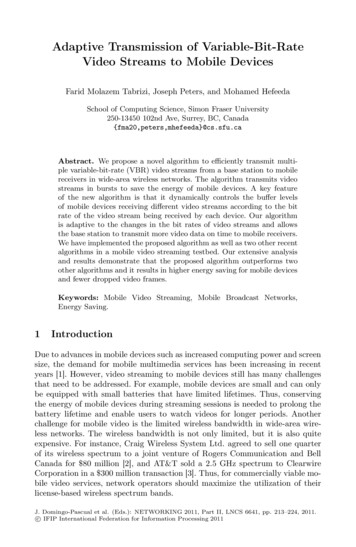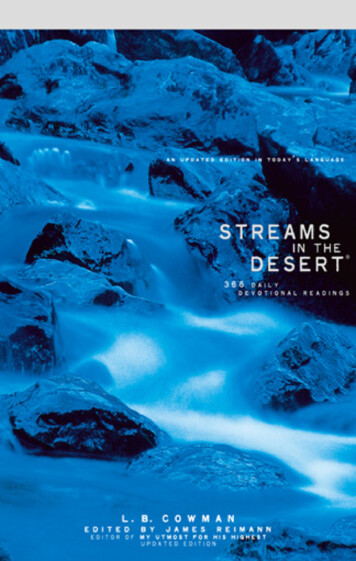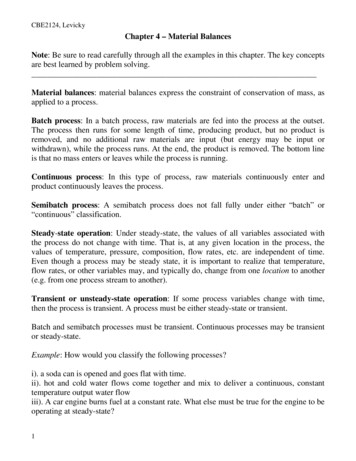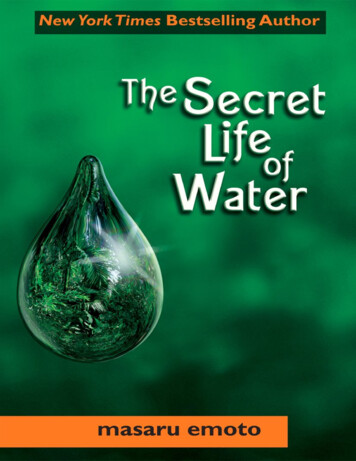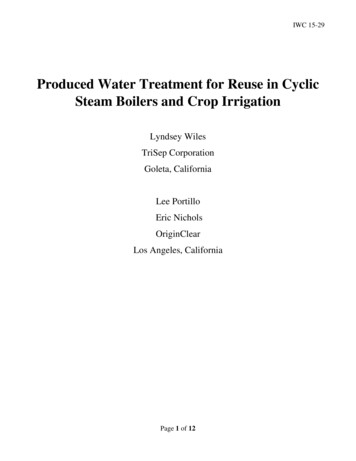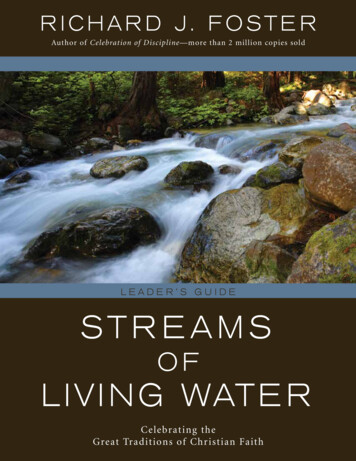
Transcription
R ICHAR D J. FOSTE RAuthor of Celebration of Discipline—more than 2 million copies soldLEADER’S GUIDESTR EAMSOFL I V I N G WAT E RCelebrating theGreat Traditions of Chr istian Faith
R e s o u r c eG u i d e
Books by Richard J. FosternnnnnnnnnnnnStreams of Living Water: Celebrating the Great Traditions of Christian FaithThe Renovaré Spiritual Formation Bible (Editor)Celebration of Discipline: The Path to Spiritual GrowthCelebrating the Disciplines (with Kathryn A. Yanni)The Challenge of the Disciplined LifeDevotional Classics (edited with James Bryan Smith)Freedom of SimplicityPrayer: Finding the Heart’s True HomePrayers From the HeartRichard J. Foster’s Study Guide for Celebration of DisciplineSeeking the KingdomSpiritual Classics (edited with Emilie Griffin)Books by Gary W. Moon/Other ResourcesVideo Curriculum (Curriculum of Christlikeness Series)n God Views: Seeing Clearly the One Who Loves You Mostn Renovation of the Heartn Celebration of Discipline: The Path to Spiritual GrowthFamily Devotion/Children’s Curriculumn The Bible Ride: Adventures That Bring the Gospel to Life (Volumes 1-4)n The Bible Ride Atlas (Volumes 1-4)n The Bible Ride Scenic Route (Volumes 1-4)Also by the Author:n Homesick for Eden: A Soul’s Journey to Joyn Falling for God: Saying Yes to His Extravagant Proposaln Spiritual Direction and the Care of Souls: A Guide to Christian Approaches and Practices(edited by Gary W. Moon and David G. Benner)To Contact the 00.541.1376LifeSprings Resources2425 West Main StreetP.O. Box 9Franklin Springs, GA 30639-0009Last updated July 20132013099
Streams ofLiving WaterCelebrating the Great Traditionsof Christian FaithResource GuideGary W. Moon
Streams of Living Water: Resource GuideCopyright 2007 by LifeSprings ResourcesAll rights reserved. No part of this publication may be reproduced, stored in a retrieval system, ortransmitted in any form or by any means—electronic, mechanical, photocopy, recording, or anyother—except for brief quotations in printed reviews, without the prior permission of the publisher.Requests for information should be addressed to:LifeSprings ResourcesP.O. Box 9Franklin Springs, GA 30639ISBN: 1-932776-15-XAll Scripture quotations, unless otherwise indicated, are from the New Revised Standard VersionBible, copyright 1989, Division of Christian Education of the National Council of the Churches ofChrist in the United States of America. Used by permission. All rights reserved.Written by Gary W. MoonDesigned by Jeffrey Hayes JohnsonPrinted in the United States of America
ContentsIntroduction . 7Foreword . 7How This Resource Guide Is Organized . 8Before the First Session . 9Tips for Leading Group Discussion . 10Tips for Using the DVD . 11Final Word . 11Session 1:Imitatio: The Divine Paradigm . 13Session 2:Understanding the Contemplative Tradition . 27Session 3:Experiencing the Contemplative Tradition . 38Session 4:Understanding the Holiness Tradition . 48Session 5:Experiencing the Holiness Tradition . 59Session 6:Understanding the Charismatic Tradition . 68Session 7:Experiencing the Charismatic Tradition . 79Session 8:Understanding the Social Justice Tradition . 88Session 9:Experiencing the Social Justice Tradition . 99Session 10: Understanding the Evangelical Tradition . 108Session 11: Experiencing the Evangelical Tradition . 120Session 12: Understanding the Incarnational Tradition . 130Session 13: Experiencing the Incarnational Tradition . 142List of Works Cited . 152
IntroductionForewordWelcome to the fourth installment of the DVD-based Curriculum ofChristlikeness series! If you’ve been with us from the beginning, you know that westarted with God Views, which featured the drama and comedy of Curt Cloninger.We began there because a person’s view of God is the most fundamental elementof Christian formation. To misperceive God may result in a lifetime of avoiding hispresence. But to see God clearly is to discover that the most powerful being in theuniverse is our compassionate Father.In the second installment Dallas Willard presented the next step, anintentional plan for Renovation of the Heart. He explored the six differentcomponents of you—thoughts, emotions, will, behavior, social relationships,and soul—and how the VIM (Vision, Intention, Means) model for spiritualtransformation is a reliable pattern for change.In our third course, Richard J. Foster taught his classic text Celebration ofDiscipline as a fresh reminder of how the classical spiritual disciplines are waysby which we can live connected to God. In the words of Eugene Peterson, authorof The Message, “Richard J. Foster has ‘found’ the spiritual disciplines that themodern world stored away and forgot, and has excitedly called us to celebratethem. For they are, as he shows us, the instruments of joy, the way into matureChristian spirituality and abundant life.”It is appropriate that our fourth curriculum component also featuresRichard J. Foster and his book Streams of Living Water: Celebrating the GreatTraditions of Christian Faith. Why? A maturing follower of Jesus sees God clearly,has entered into an apprenticeship program for heart renovation, engages in theclassical spiritual disciplines as ways of being with God, and is willing to leavehis or her comfort zones to drink deeply from each of the streams of Christianspirituality. Streams of Living Water is an invitation to live a balanced and wellrounded apprenticeship with Jesus.Foster begins Streams of Living Water with the assertion that Jesus is thesource of each of the great traditions of Christian spirituality—Contemplative (theprayer-filled life), Holiness (the virtuous life), Charismatic (the Spirit-empoweredlife), Social Justice (the compassionate life), Evangelical (the Word-centered life)and Incarnational (the sacramental life).Once Foster persuades us that each tradition has its source in the life ofJesus, he devotes a chapter to each of the six traditions. Using his exceptionalgifts of story-telling and eyebrow-raising insights, he provides us with historical,biblical, and contemporary examples of each rushing stream. He also offersdefinitional clarity and an honest appraisal of the major strengths and potential7streamsoflivingwater
INTRODUCTIONpitfalls of each. But perhaps most importantly, Richard Foster leaves the readerwith the same desires experienced while reading Celebration of Discipline—ayearning to practice and experience.We are glad you are joining us for this curriculum. You’ll observe Richardas he teaches about each of the tributaries and again as he converses witha key representative of each stream. So if you are a person on a journey ofspiritual transformation, we think you will be enriched by the curriculum and beencouraged to become even more balanced and holistic as you leave your comfortzone and wade into these six streams of living water.How This Resource Guide Is OrganizedOverview:This Resource Guide is divided into 13 sessions (lessons). Each 45- to60-minute session involves an integration of a section of the Streams ofLiving Water DVD with material presented in the Leader’s Guide andParticipant’s Guide.For each session, the leader will need:nnnnnLeader’s GuideBibleDVD Player, Monitor, Stand, Extension Cord, etc.Streams of Living Water DVDStreams of Living Water (the book)For each session, the participant will need:n Biblen Participant’s Guide (Optional)n Pen or PencilEach session is divided into seven parts:n Before You Leadn Introductionn Warm-Upn DVDn Bible Studyn Transforming Exercisesn SummaryLeader’sGuide8
INTRODUCTIONBefore You LeadBefore the lesson itself, you will be presented with a brief overview that willinclude important quotes, Scripture reference, list of materials needed, andthe lesson outline. All you need to be an effective group leader is containedwithin this packet and between your ears. However, you and the groupparticipants are encouraged to read or reread the corresponding chapterfrom Streams of Living Water before class each week.n QuotesQuotes from Streams of Living Water and other Renovaré resources areprovided as a way to focus each session.n Scripture ReferenceOne or more passages of Scripture are provided to underscore how each ofthe great traditions is tied to the biblical text.n MaterialsThe materials listed are important for both leader and participants. Thecorresponding chapter from Streams of Living Water will be listed here.n Session OutlineThis is an at-a-glance overview of the content and activities to be coveredduring the lesson.Be f o r e th e F i r s t S es s i o nqThe Streams of Living Water curriculum is designed to be user-friendly. We knowit is the rare teacher who has several hours each week to prepare for leading class.We suggest the following preparation (probably less than one hour of your time):rWatch the appropriate video segment and have DVD cued for class.sMake sure there will be enough pens or pencils for the participants.tFamiliarize yourself with the standard structure of presentation(see above).uRead through the Leader’s Guide for the lesson, and use the margins for notes.9streamsoflivingwater
INTRODUCTIONUniqu e Fe a t u r e sqrNo requirements for students before coming to class—although they shouldbe encouraged to read the corresponding chapters from Streams of LivingWater.Homework and additional readings for students who become inspiredduring class and want to go further.stMore material that you will need—exercises can become homework.uFlexibility concerning presentation style (e.g., you may use a small-group orlarge-group format for discussion and use of exercises).The leader is more of a facilitator than a verse-by-verse teacher.Tips for Leading Group DiscussionqAllow group members to participate at their own comfort levels. Noteveryone need answer every question.rAsk questions with interest and warmth, and then listen carefully toindividual responses. Remember: No answer is too insignificant. Encourageand affirm each person’s participation.sBe flexible: Reword questions if necessary. Take the liberty of adding ordeleting questions to accommodate the needs of your group.And speaking of flexibility, whenever discussion times are teeming withlife, do not feel obligated to complete the entire session plan. As a rule ofthumb, good discussion beats a structured lesson, but the recommendedstructure beats lifeless discussion. Again, flexibility and sensitivity are thekeys. Any of the exercises can become homework assignments if the groupbecomes pressed for time due to helpful and energetic discussion.tuAsk for (and expect) differences of opinion and experience.Don’t be afraid of silence. Allow people time to think. Digestion takes time.Leader’sGuide10
INTRODUCTIONvwxNever force someone to disclose homework or journaling activities. In fact,assure them up front that such disclosure will never be required.Many items in your session notes (particularly those labeled “ClassResponse” and “Questions,”) are written in second person to allow theleader to read these words directly to the participants.Allow participants to decide if they would prefer to do exercises in smallgroups (four to six members) or as a large group (entire class)Tips for Using the DVDqrstuBefore class time, always view the section of the DVD to be shown in class.When you listen to the DVD, walk through all areas of the room to makesure the volume is set correctly.Have the DVD cued to the right place to start.Make sure all the equipment you need is in class and appropriatelyconnected. This may mean arriving early for class—allowing enough timeto preview the DVD.Make sure before your students arrive for class that your video equipment isin good working order.Final WordPlease note that you will be provided with more material than you need for a 45- to60-minute group session. We recommend one of three approaches for handling thisbounty of teaching resources:q11We have tried to help you a bit by providing either a Bible Study or a Small GroupExercise every week. A Bible Study will be found in the introductory lesson andlessons labeled “Understanding” a particular tradition. A Small Group Exercisewill be provided with the lessons labeled “Experiencing” the traditions.streamsoflivingwater
INTRODUCTIONrsYou may desire to use two sessions to cover each chapter. If you choose thisapproach, you’ll want to spend one session viewing the DVD content andproviding time for discussion. The second session on the topic would bedevoted to either the Bible Study or the Small Group Exercise.Use the materials as part of an extended retreat, again deciding whether tospend one or two sessions on each chapter.Please note an important difference between this and previous installmentsin the Curriculum of Christlikeness series: Starting with session two, Streamsof Living Water alternates between a Bible Study and a Small Group Exercise forthe in-class group activity instead of having both in each session as did God Views,Renovation of the Heart, and Celebration of Discipline.The Participant’s Guide features a Bible Study, Daily Scripture Readings, andIndividual Exercises in the even-numbered sessions, which focus on “understanding”each Stream of Christianity. The Participant’s Guide features a Small GroupExercise and a self-examination exercise (Celebrating Strengths and MinimizingWeaknesses) in the odd-numbered sessions, which focus on “experiencing” eachStream.In the first session on each Stream (the “understanding” session), the leaderwill point participants to the Individual Exercises in that week’s section of theParticipant’s Guide as an activity they may want to do at home in the coming week.Then in the next session, if participants wish, they can discuss their experienceswith those exercises.In the second session on each Stream (the “experiencing” session), the leaderwill point participants ahead to the Daily Scripture Readings in the next sectionof the Participant’s Guide. The participants may wish to read and meditate onthese passages of Scripture in preparation for the following week’s session onunderstanding the next Stream. You and your class may choose to discuss insightsexperienced and questions raised by these Scripture meditations.Leader’sGuide12
SESSION ONE:Imitatio: TheDivine ParadigmBEFORE YOU LEADn Quotes and QuipsAs Jesus walked this earth, living and working among all kinds andclasses of people, he gave us the divine paradigm for conjugatingall the verbs of our living.Richard J. FosterThe Church exists for nothing else but to draw men into Christ,to make them little Christs. If they are not doing that, all thecathedrals, clergy, missions, sermons, even the Bible itself, aresimply a waste of time.C. S. Lewis[God] offers life, but we must choose to live. This is a far differentthing than choosing to be “saved” or accepting “salvation.” This isno matter of mere belief but a description of how one lives.George MacDonaldn Key ScripturesLet the one who believes in me drink. Out of the believer’s heartshall flow rivers of living water.John 7:3813streamsoflivingwater
SessionOne[I ask] that they may all be one. As you, Father, are in me and I amin you, may they also be in us, so that the world may believe thatyou have sent me.John 17:21If while we were enemies, we were reconciled to God through thedeath of his Son, much more surely, having been reconciled, will webe saved by his life.Romans 5:10n Note to LeaderBy design, the Leader’s Guideprovides you with more resourcesthan you can possibly use in a typical45- to 60-minute group meeting. Hereis what we suggest. In the appendixsection of each session you will find aone-page Teaching Outline sheet tohelp you organize your presentation.Find it first (see appendix, p. 34) anduse it each week for note taking asyou read through the chapter.Which resources and ideas youuse will depend on you and thedesires of your group. We assumethat each group will want to viewthe video vignettes on DVD, whichfeature either a presentationby Richard J. Foster or aconversation between Richard and arepresentative of one of the six greattraditions of Christian faith. Thesevideo vignettes average 22 minutesin length. (Note: It is a good idea topreview the video session before eachclass.)Following each of these 13segments, the DVD continues fora brief “Soul Talk” session in whichRichard Foster and Dallas Willardengage in candid conversation on topicsinspired by the initial vignette. These areresourceguideSESSION OUTLINEI. Introductionn Welcomen PrayerII. Warm-Upn Overview/IllustrationIII. DVDn Video Vignetten Central Truthsn Class Responsen Reflection QuestionsIV. Bible Studyn Leader’s Insightn Group Exercisen Daily Scripture ReadingsV. Exercisesn In-Class Small Group Exercisen Homework Assigned for: Thoughts Emotions Will Behavior Social InteractionsVI. Summaryn Richard’s Recommendationsn Other Renovaré Resources14
“bonus” conversations for which your group is invited to be a fly onthe wall and listen in. The average length of these conversations isthree to five minutes. You don’t want to miss them.If you choose simply to view the video segments and lead a smallgroup discussion, this will take a minimum of 30 to 40 minutes,depending, of course, on the length of discussion.Other featured resources may be seen in the Session Outline(see page 15). If your group is to meet for only one session for eachchapter in the Leader’s Guide, we suggest that you touch lightlyon each topic covered in the outline but give special emphasis(i.e., time) to only one additional feature. We help you with this byplacing a special emphasis each week on either a Bible Study or anin-class Small Group Exercise. This first session offers both a BibleStudy and a Small Group Exercise so your class can experienceeach up front; the sessions that follow will offer one or the other ona rotating basis.n MaterialsFor this session the leader will need:n Leader’s Guiden Biblen DVD player, monitor, stand, extension cord, etc.n Streams of Living Water DVDn Streams of Living Water (chapter 1)For this session the participant will need:n Biblen Participant’s Guide (Optional)n Pen or pencilIntroductionn WelcomeCall the group together and welcome the participants tosession one of Streams of Living Water: Celebrating the GreatTraditions of Christian Faith.Depending on your familiarity with the participants, you maywant to introduce yourself—tell the group your name, a little about15streamsoflivingwater
SessionOneyourself and your family, and why you are excited to be facilitatingthis particular class.n PrayerPRAYER FOR TRUST IN JESUSSt. Ignatius of LoyolaO Christ Jesus, when all is darkness and we feel our weaknessand helplessness,Give us the sense of Your Presence, Your love, and Yourstrength.Help us to have perfect trust in Your protecting love andstrengthening power,So that nothing may frighten or worry us,For living close to You, we shall seeYour Hand,Your purpose,Your will through all things.Amen.Warm-Upn Overview and IllustrationRenovaré is a Latin word meaning “to renew.” If you visit theRenovaré web site www.renovare.org/ you will find the front door toan organization committed to the renewal of the Church of JesusChrist. The mission is “to provide individual churches and theirmembers with a balanced, practical, effective small-group strategyfor spiritual growth” (see A Spiritual Formation Workbook, p. 11).Part of Renovaré’s plan for helping followers of Christexperience the “abundant life” Jesus promised (John 10:10) is toprovide a balanced vision for Christian living that incorporatesspiritual disciplines and practices from each of the great traditionsof Christian faith:nnnnnnContemplative: the Prayer-Filled LifeHoliness: the Virtuous LifeCharismatic: the Spirit-Empowered LifeSocial Justice: the Compassionate LifeEvangelical: the Word-Centered LifeIncarnational: the Sacramental Liferesourceguide16
In considering the importance of an approach to Christianspiritual formation that is both balanced and holistic, it may behelpful to consider the examples of diet, dance, and Jesus.n A Balanced Diet: We Are What We EatMost respected diet plans point to the need for balance in oureating habits. Such plans suggest a focus on six different foodgroups: Whole grainsVegetablesFruitsNuts, legumes, and lean meatsLow-fat dairy productsHealthy fats such as olive oilWhile it is true that some of these foodtypes—such as vegetables and fruit—can be eaten in abundance,the healthiest diet is a balanced one. In fact, if a person decided toeat only one source of nutrition, he or she would be considered tosuffer from an eating disorder and would be harmed by nutritionalimbalance over the course of a lifetime .In a similar manner Renovaré recommends an approach tospiritual growth that includes the healthy recommendation that wefind our sustenance from all six staples for healthy spiritual life.n A Holistic Approach to Learning and LivingHealthy spiritual living is balanced, and it is also holistic.Consider the example of a performance by an expert dancer. She isable to perform at highest level only by drawing from all six aspectsof herself: BodyThoughtEmotion WillRelationshipSoulDance is a behavior, a movement, but much more than the bodyis involved. The true artist is performing by applying all the aspects17streamsoflivingwater
SessionOneof her person. The dancing behavior is guided by thinking (yearsof studying theories and technique), emotions (allowing feelingsto flow through the body), and choice (the decision to practice forthousands of hours instead of vegetating on a sofa). And dance ismost magical when done in relationship, two or more people movingas one. When all five of these aspects of the person are engaged inproducing the dance, a sixth is evident—the dance has soul; thedancers have leaped into the rhythms and have become the music.Dance, like Christian living, rises to its highest level of expressionwhen all the components of the person—body, thoughts, emotions,will, and relationship—holistically function as one.n Jesus Our ExampleThe classic streams of Christian life, the great traditions of theChristian faith, are seen in their fullest forms in Jesus’ balanced andholistic approach to living. Consider these observations(see A Spiritual Formation Workbook, p. 26): We see Jesus praying, and we listen to his teaching on the life ofintimacy with God. We see Jesus battling with Satan in the wilderness, and we listento his teaching on the importance of a pure heart. We see Jesus ministering in great power, and we listen to histeaching on the comfort, wisdom, and strength that come fromthe Holy Spirit. We see Jesus helping the sick and the needy, and we listen to histeaching on the importance of caring for our neighbor. We see Jesus proclaiming the good news of the kingdom ofheaven, and we listen to him reading from the Scriptures. We see Jesus integrating sacred and secular while observing theceremonies.n Homework Check-UpWe suggest that the group participants obtain a copy of Streamsof Living Water: Celebrating the Great Traditions of Christian Faithand read the corresponding chapter prior to each session. You maywant to inform them that after this initial session, two sessions willbe devoted to each chapter that presents a particular tradition. Forexample, sessions two and three will focus on the ContemplativeStream. Each week there will be a time for the participants to checkin and discuss their interactions with the “homework” assignments(more on this later).resourceguide18
DVDn Video VignetteToday’s video segment will give you the opportunity to listento Richard J. Foster as he introduces Streams of Living Water byteaching about the Imitatio as the Divine paradigm for our Christianliving.During your time in this course, you will see 13 vignettes—onefor the first chapter of Streams of Living Water and then two apiecefor the six remaining chapters. In this first vignette—as well as foreach of the even-numbered sessions—Richard follows a similarteaching pattern. First, he introduces the topic, or Stream—Imitatio, Contemplative, Holiness, Charismatic, Evangelical, SocialJustice, and Incarnational—by providing a vision for its importance.He then offers two stories (biblical and historical) about individualswho represent the tradition. Richard concludes these teachings witha personal and practical reflection concerning why the particularStream is important to your life.In the odd-numbered sessions, Richard will be joined by arepresentative of each of the traditions for a frank and transparentconversation. Representatives of the various Streams include:nnnnnnSession 3: Contemplative—Glandion CarneySession 5: Holiness—James Bryan SmithSession 7: Charismatic—Jack HayfordSession 9: Social Justice—Juanita RasmusSession 11: Evangelical—John OrtbergSession 13: Incarnational—Emilie GriffinDuring the conversation, each guest will share the importance ofthe particular Stream in his or her own life. The guest will also sharea story about a contemporary figure who has been influential in hisor her spiritual growth. Discussion will follow concerning the keystrengths and potential pitfalls of the Stream, and the conversationswill conclude with personal and practical disclosure from devotionalor living practices.But you may not want to turn off the DVD player. After eachteaching session, a special bonus feature includes excerpts from aconversation between Richard J. Foster and Dallas Willard. You areinvited to stick around and be a fly on the wall for their unscripted“Soul Talk.”19streamsoflivingwater
SessionOneEach week there will be approximately 22 minutes of videopresentation and an additional 3 to 5 minutes of “Soul Talk”conversation between Richard and Dallas Willard.n Central Truths(p. 8 in Participant’s Guide)You are provided with a few summary points for the teaching sectionof each video vignette. Here are the Central Truths for the first videosession.Richardn Now, for the first time in living memory the River of God isflowing in great power and gathering into itself Streams thathave been separated from one another for a very long time.n The previously “isolated streams” that are once againbeginning to flow together are: The Contemplative Stream or the Prayer-Filled Life. The Holiness Stream or the Virtuous Life The Charismatic Stream or the Spirit-Empowered Life The Social Justice Stream or the Compassionate Life The Evangelical Stream or the Word-Centered Life The Incarnational Stream or the Sacramental Lifen These great Streams of life and power are also historicaltraditions and important dimensions of our own spiritual life.n Jesus is the perfect model for these six Streams flowingtogether into a single life.n Jesus is the single most important person in all humanhistory; he is the Maestro of life; he has come to give Masterlessons in how to live life well.n The value of the kingdom of heaven is so high that peoplehearing Jesus were knocking down the doors to get in!n The pearl of great price is the kingdom in all its fullness; weshould not be easily satisfied with lesser pearls, such as a setof doctrines, a set of moral ethics, or even a set of religiousexperiences.n In prayer we can experience letting go of the little pearls andseeking the pearl of great price.Richard and Dallasn Dallas offers “scenes” from the Gospels for how each Streamflows out of the life of Jesus.n It is rare to find churches where all of the Streams flow freelybecause it is rare to find a church where all six Streams aretaught as part of healthy Christian spirituality.resourceguide20
n Class ResponseDo you have any questions or observations about the videovignettes before we look at the Reflection Questions together?n Reflection Questions (p. 9 in Participant’s Guide)VideoqRichard says, “God is doing a daring, new thing in our day.”How would you describe that new thing?rTell about any positive experiences you have had with one ormore of the six Streams.sWhat does it mean to you, personally, to say that Jesus is theMaestro of life? What would you like for it to mean?tWhat is your motivation for being willing to trade in any littlepearls you may possess for the pearl of great price?uWhat advice did Richard Foster’s wife give him concerninghis hair?vFrom Richard a
Streams of Living Water is an invitation to live a balanced and well-rounded apprenticeship with Jesus. Foster begins Streams of Living Water with the assertion that Jesus is the source of each of the great traditions of Christian spirituality—Contemplative (the prayer-filled life), Holine

